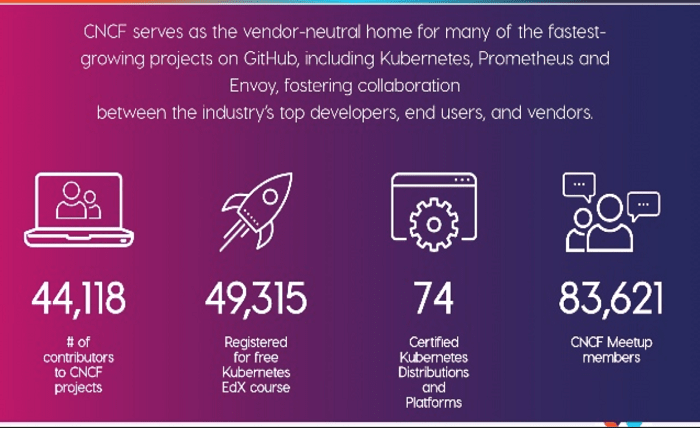
Top Benefits of Adopting Kubernetes
Kubernetes has rapidly become one of the leading cloud technology for the right reasons. Kubernetes lets you create modern-day applications that are flexible, scalable, and resilient to faults. You define the state you want your environment to be in. It works continuously to maintain the state that frees developers from the tedious task of infrastructure management.
While there are many advantages of Kubernetes however, there are issues. VMware recently released a study of a survey of businesses currently using Kubernetes that provides an insight into how companies are making use of Kubernetes and navigating the obstacles to make the most of their investment.
The Benefits Of Kubernetes Adoption
In the study by VMware, almost all participants (95 percent) said they had seen tangible benefits in using Kubernetes. The most popular benefits reported include:
- Increased utilization of resources
- Reduced development times for software
- Monolithic containerized applications
- Cloud-based move enabled
- Costs of cloud services reduced for public cloud
- If you visit this site you can more information mynewsweb and by visiting this site you can know this about activesnet. To find more information about importance of edunewszone
Respondents indicate that Kubernetes is beneficial for multiple stakeholders within the organization improved resource utilization is a KPI for operations, faster development is a priority for developers, and reducing public cloud costs is critical for finance and executive teams. You can learn more about how to set up your own Kubernetes Cluster, configure networking between pods and secure the cluster against unauthorized access, and more from the Kubernetes Certification.
Four Hurdles To A Success Kubernetes Adoption
Yet, many companies have to encounter myriad obstacles before they realize the advantages of operating Kubernetes. In this article, we’ll examine the four main barriers preventing organizations from achieving their goals. We’ll also offer recommendations on how to overcome them.
- Inexperience And Lack Of Expertise
Based on the survey findings, lack of knowledge and experience was the top issue cited by 67% of respondents. Even though Kubernetes and container use are growing quickly. However, many companies have a long learning curve to efficiently construct deployment, manage, and maintain Kubernetes. It is because of its infancy and lack of operational precedent to the technology.
To overcome this obstacle, There are a variety of strategies your business can employ:
- Learning through pairing: Gartner recommends the practice of “pair programming” it is “the concept of putting two people with a greater amount of experience than the other in a specific field, to work two-way setting. This allows less experienced people to learn one-on-one and benefit from the expertise of experienced developers.”
- Educational along with training programs: Cloud service providers and other companies offer training and certification programs specifically designed for developers, administrators, and other users of the cloud who want to know Kubernetes’ best practices within your company cloud environment.
- Partners: To overcome a lack of knowledge within your company, a Partner can guide the decision-making process and help balance different IT priorities in your company. Find partners with specific knowledge, experience, and solutions to Kubernetes design and operation.
- you should try this site happy2hub and click here to know more about worldupdate and if you use this site you will find a lot of information about thewebnews.
- Internal Alignment Issues
With several aspects involved in the decision-making process, you integrate, how to manage Kubernetes is more challenging. Responding to the survey, 83% of the respondents indicated that several teams are involved when selecting the Kubernetes distribution, with 40 percent citing insufficient internal alignment as a problem when choosing the Kubernetes distribution.
Setting up the Cloud Center of Excellence (CCoE), also called a Cloud Business Office, Cloud Strategy Office, and a Cloud Program Office, can be the most effective methods to get past this hurdle. A CCoE is a team of cross-functional experts responsible for coordinating and supporting the implementation of an organization’s cloud strategy in terms of operations, cloud financial management, security and security, and compliance. With an established CCoE, it is possible for organizations to better align individual choices (including those related to the integration of Kubernetes and its management) within the context of the business’s objectives.
- Monitoring and Visibility
While Kubernetes is often referred to as a cloud-native platform but it’s also employed in on-premises environments. Indeed, the majority of respondents (64 percent) said they had deployed Kubernetes on-premises, with 42% in one cloud, and 31% in multiple cloud services. Enterprises that deploy Kubernetes clusters that span on-premises or multiple cloud providers or managed services create an increase in complexity and fragmentation.
To reap the maximum benefits of Kubernetes (and in order to prevent spending too much security or issues with performance) companies must be in a position to see all aspects of their Kubernetes environment, which includes the entire set of entities (applications containers, pods namespaces, nodes, etc. ) and their dependencies as well as how these interact one and each.
- Compliance With Security And Security Requirements
Nearly half (46 percent) of respondents in the survey mentioned difficulties in meeting security and compliance requirements following the deployment of Kubernetes. Due to the particular characteristics of Kubernetes and containers, a single oversight or mistake can be repeated hundreds or even many times.
Like all technologies, Kubernetes is only as secure as the implementation and design of its environment. The CCoE should establish and define the standards for configuration to ensure a secure cloud security framework without compromising productivity. For instance, you can assign permissions to roles that are based on the least privilege, to restrict to a certain number of people who have root access. Or, look into disabling privilege-based containers, so that access to the resources hosted by the system is limited.
With the proper management tool installed The CCoE can establish policies to examine the environment and inform appropriate stakeholders about suspicious activity, anomalies, and other security flaws prior to an incident occurrence and even perform remediation actions the issue automatically.
How Do You Navigate These Issues
Many companies want to reap the advantages of Kubernetes. However, they struggle to justify the amount of time, resources, and expense required to create and maintain it in-house. Our customers utilize VMware Tanzu to arrange the Kubernetes clusters across their infrastructures, establish rules for their clusters’ access and usage, and allow their teams to set up Kubernetes clusters using a self-service approach.
This allows operations and infrastructure teams to have visibility and control over their Kubernetes infrastructure while permitting developers to use these resources with a concentration on solving problems instead of stressing about infrastructure.




